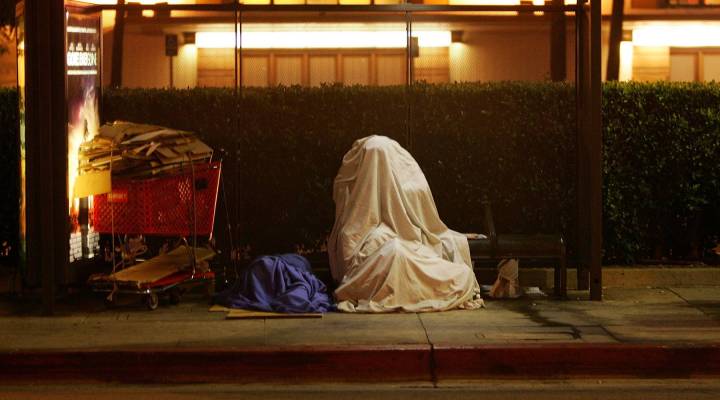
In Los Angeles, progress in getting vets into housing

A recent census of the homeless in Los Angeles County found that the overall numbers have increased almost 6 percent. But there was a bright spot. In the last year, the number of homeless veterans fell by 30 percent. Even more dramatic, the number of vets living on the streets decreased by 44 percent.
The case of Larry Daniels is an example of a successful Veterans Administration program.
Daniels, 69, was forced onto the streets.
“We were living in Long Beach, me and my wife, and we were evicted illegally,” he said.
“We had never been homeless,” his wife, Jacqueline, said. “Never.”
They ended up living in a shelter on Skid Row.
“I was never so glad to get from down there,” Jacqueline said. “Them poor people living on the street. Shooting heroin right there. It’s a horrible scene.”
Last September, they moved into a one-bedroom apartment in a brand new building.
“Everybody, when they come, they say, ‘Oh, this is just beautiful,'” she said. “And I’m like, ‘I know.'” Jacqueline said. “I’m just grateful that we were chosen.”
They were chosen because Larry is a veteran. In fact, the whole building is occupied by vets. And they all have a dedicated case manager who helps with financial issues.
For example, Larry is in a dispute with an auto loan company. “They repossessed my car, mistakenly,” he said. “They wanted to give the car back and wanted me to re-finance. So I told them to take the car and shove it.”
Instead, a settlement was reached. Larry’s case manager, Michael Edwards, is helping them to collect the $5,000 that they’re owed. But it hasn’t been received yet.
Some of the other vets need more than just financial help. Edwards said some residents still act like they’re homeless. “Some of them have been on the streets for quite some time,” he said. “And it’s hard to get out of that behavior. But if they got somebody monitoring their behavior, trying to help them change their attitude, then that’s what we’re here for. And to keep them housed.”
Vets like Larry Daniels are getting moved off the streets faster because Veterans Affairs is adopting a model known as Housing First.
“It’s the whole idea of taking a veteran, connecting with them, putting a roof over their head first, and then surrounding them with all the services that they need to be successful,” said Heidi Marston, a special assistant to the secretary of Veterans Affairs. “Because it really starts with having a bed to sleep in at night and a place where you feel safe, that’s your own.”
The VA is partnering with the Department of Housing and Urban Development to get veterans housed and supported with case managers. Between them, the two departments are spending around $20,000 per vet.
Vince Kane, who is also a special assistant to the secretary of Veterans Affairs, said the program is less expensive than leaving a homeless veteran on the streets.
“When you have them in housing, use of ERs, use of medical services, unnecessary in-patient hospitalizations — whether it’s for medical care or psychiatric care — incarceration, all those things go down,” Kane said.
One of the pioneers of Housing First is Sam Tsemberis, founder and CEO of Pathways to Housing National. He’s seen success with the model in cities across the country.
Now he’s helping the VA. He said its collaboration with HUD is particularly effective.
“The HUD-VA program, I would say is the singular most effective example in the United States where you have two federal agencies for the first time collaborating on a really important social issue,” Tsemberis said. “And actually putting in the millions and millions of dollars that it takes.”
The VA and HUD are spending around $116 million a year on the program in Los Angeles.
The city of Los Angeles is embracing a similar strategy. Los Angeles plans to put the bulk of its resources behind the housing first model in its own efforts to combat homelessness.
There’s a lot happening in the world. Through it all, Marketplace is here for you.
You rely on Marketplace to break down the world’s events and tell you how it affects you in a fact-based, approachable way. We rely on your financial support to keep making that possible.
Your donation today powers the independent journalism that you rely on. For just $5/month, you can help sustain Marketplace so we can keep reporting on the things that matter to you.












